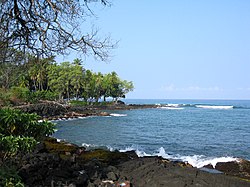Holualoa Bay
|
Holualoa 4 Archeological District
Kamoa Point Complex |
|

Kamoa Point on Hōlualoa Bay
|
|
| Location | Aliʻi Drive, Kailua-Kona, Hawaii |
|---|---|
| Coordinates | 19°36′7.78″N 155°58′29.4″W / 19.6021611°N 155.974833°WCoordinates: 19°36′7.78″N 155°58′29.4″W / 19.6021611°N 155.974833°W |
| Area | 28.4 acres (115,000 m2) |
| Built | 1300 - 1800 |
| Architectural style | Ancient Hawaii |
| NRHP Reference # |
83000247 05000542 |
| Added to NRHP | June 8, 2005 |
Hōlualoa Bay is a historic area between Kailua-Kona and Keauhou Bay in the Kona District of the Big Island of Hawaiʻi. The community now called Hōlualoa is uphill (mauka in the Hawaiian Language) from this bay. The name means "long slide" in the Hawaiian Language, from the long trail that went from a forest on the slopes of Hualālai (where the village is now), to a site where the logs were made into canoes (on the grounds of Sadie Seymour Botanical Gardens) into this bay where a large royal building complex was built over several centuries.
Keakealaniwahine, one of the first known Aliʻi Aimoku wahine ("Queens") of the entire island of Hawaiʻi, built a large complex of buildings here in the seventeenth century, with the area settled several hundred years before that. The royal complex included residential areas, as well as Heiaus (ancient temples) called Hikapaia (for plentiful food and fish) and Hualani (for teaching about medicinal herbs), and burial areas. Keakamahana, the mother of Keakealaniwahine, was the first named royalty to live here. This area (uphill or mauka of Aliʻi drive) was added to the National Register of Historic Places on June 8, 2005, as the Holualoa 4 Archeological District with site number 05000542. It is State Archeological site number 50-10-37-23.661.
The Kamoa Point Complex, the area West of Aliʻi drive on the south side of the bay, included a temple for surfers, called the Haleʻaʻama Heiau, and a large ancient sports complex named after chiefess Keolonāhihi, thought to have lived circa 1300. Here warriers could practice their skills. Some legends say Keolonāhihi was the daughter of Paʻao, the (perhaps mythical) priest who brought the Hawaiian Religion from a distant land. It was added to over the years, including a terraced grandstand to watch surfing contests.
...
Wikipedia

